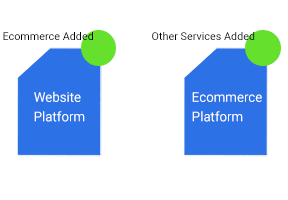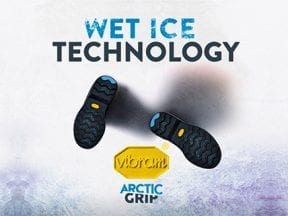Massachusetts-based Battic Door is 15 years in the making. With a credit-card investment of $5,000, owner Mark Tyrol has turned his home-insulation ideas into $1.5 million of annual sales.
“I found a manufacturer locally, and I created the website to sell the product on. The first day I turned on the website I sold my first product.”
That first product was an insulated attic-stair cover dubbed the “Battic Door.” Designed to meet new International Energy Conservation Codes for sealed access points, the R-50 cover insulates pull-down ladders and attic-door hatches.

Mark Tyrol
Within a year Tyrol recovered his initial $5,000 investment. Since then he has acquired a 7,500-square-foot warehouse to distribute a range of home-energy products. This includes vent covers, insulated pet doors, furnace insulators, and exclusive U.S. distribution for the Fireplace Plug, an inflatable fireplace insulator, which has generated more than $1 million in sales in five years.
Tyrol still works days as a senior engineer for FM Approvals, an independent testing and certification service. But on mornings, evenings, and weekends, he continues to grow Battic Door through direct fulfillment, online retail partnerships, influencer marketing, and related products.
“The theme for us is low-cost, efficient ways to make your home more comfortable by stopping drafts. As a company, we’ve been able to attract a larger audience to our website. Adding other people’s products has been a good way to grow. Someone might be looking for a stair cover from us, and buy something additional. By having over 60 products with a general purpose and theme, we are able to attract people to our website who are likely to find something they like.”
Patents and Trademarks
Tyrol owns four trademarks under the Battic Door brand.
“I learned a lesson the hard way. I started selling a product that I created, to test the market. After some success with the product, I filed for a patent — and realized that because the product had already been sold, it eliminated the ability to get a patent for it.”
He was, however, able to receive a trademark for it. He has since hired a patent attorney and offers this advice: “It does take a lot of time and expense to secure IP (intellectual property). Be prepared to spend $10,000.”
Third-party Retail Channels
Starting initially with his website, Tyrol grew his ecommerce business by adding online channels.
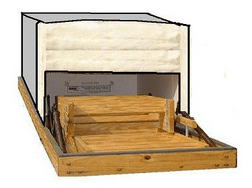
The Battic Door, an insulated attic-stair cover.
“I added eBay, Amazon, Rakuten, Sears, HomeDepot.com, Walmart.com, Facebook, and many more. Over the last 15 years, we have grown 20 to 25 percent per year, on average, from the addition of new online portals.”
Roughly 60 percent of Battic Door’s revenue now comes from those channels.
“Each of these merchants, from Walmart to Menards and Amazon Canada, has its own portal to download orders. Then you process the order and upload the tracking details and shipping information. Then you go through an invoicing process to confirm shipment.”
Marketplaces take fees for every item sold. Amazon, at 18 percent, is “by far the most expensive channel. But the popularity and security of Amazon’s website and the exposure it provides outweigh the costs.” Other channels, such as Home Depot and Walmart, pay an agreed price for each item sold. Those portals also pay the shipping.
Each portal is different, in other words.
Getting the Contract
Battic Door’s first reseller was Home Depot. Tyrol submitted a supplier application and was selected to make a product demonstration — “basically a sales pitch” — at Home Depot’s Atlanta headquarters. Tyrol funded the trip with Battic Door profits and headed out on his first official Battic business trip.
“We were lucky. We had an interesting product and gave a successful presentation.” The next step was merchant onboarding.
“Once we did that, because Home Depot is a very strong channel, we were invited to several ecommerce channels.”
Employees
“My wife and I take care of the business, and we have up to six part-time people that come in and help us. Two have been with us for some time. They’re very efficient and know how to work on their own to-do tasks and help us.”
Tyrol sources the components of the products he makes from U.S. manufacturers. The components are made for Battic, and Tyrol and his team do the assembly and packaging.
Fulfillment and Shipping
About 90 percent of the products sold on BatticDoor.com are stored at its warehouse. Even the products Tyrol does not manufacture are purchased in bulk and stored there.
“We make it a priority to try to ship every order the day it comes in. By shipping the same day, by 3 p.m. from Massachusetts, many of the orders arrive next day — even with standard, ground shipping.”
“To expedite that, most of our items are pre-packaged and ready to go. We package the items into separate boxes. For multiple items, we put all of the pre-packed boxes into a larger one to send to the loading dock where our carriers — UPS, USPS, and FedEx — come and pick up throughout the day. We also ship pallets by truck, but that’s for larger, contractor-size orders.
“Most folks don’t want to pay for shipping. I don’t blame them; I feel the same way. But we try to be very transparent. We don’t hide the cost of shipping in our item price. What we’re doing is adding shipping, and they can select the speed and cost. We don’t mark up any shipping costs, and we find that customers appreciate that transparency.”
Marketing
An “influence the influencer” program has become Battic Door’s most effective and profitable marketing method. It’s a blend of trade shows and direct mail.
“We took a booth at an architect exhibition to introduce our product. We did that for two years, and we went from being specified in a handful of projects to well over 100 projects to date. Once an architect specifies us for one project, they often specify us for their next projects. So it’s really paid off.”
Rather than offering wholesale pricing, Tyrol offers free shipping on large contractor orders. And that closes the deal.
“As a direct result of our influencer marketing program, my sales have increased by roughly 50 percent in each of the last two years. I picked up dozens of new accounts that continually purchase products. Many customers tell me they were referred to us by their architect or code official, confirming the success of our influencer marketing program.”
Software
Tyrol used Dotster’s site builder to create his original website, which he still uses.
“After about five years I hired a consultant to update the site and add new graphics. Over the years I have taught myself enough that I no longer use a site builder and edit the code directly.”
The site gets more than 2 million visits a year. Tyrol updates all of its content. The website generates about a third of Battic Door’s annual sales.
Instead of an on-site shopping cart, Tyrol chose “Buy” buttons from Mal’s E-commerce.
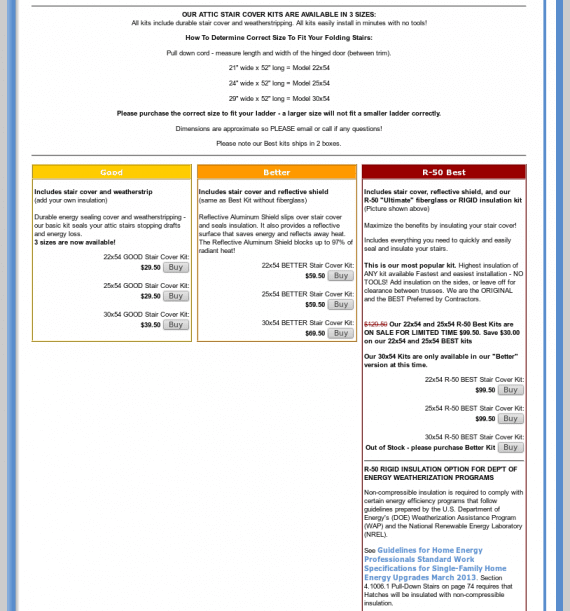
Battic Door uses “Buy” buttons that link to Mal’s E-commerce instead of an on-site cart.
Each button connects to Mal’s secure server — landing on a cart page with the Battic Door logo and the selected product added.
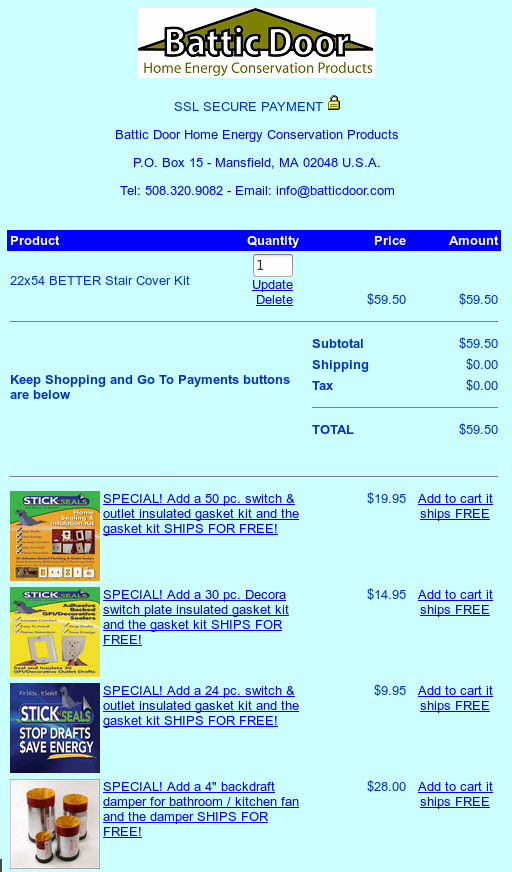
“Buy” buttons at BatticDoor.com connect to a cart page at Mal’s E-commerce, where buyers can complete their purchase.
From there, shoppers can edit their order, continue shopping, or move on to the payments section.
With Mal’s secure server, Tyrol can sell unlimited products without scripting, application installations, or separate SSL certificates. It’s free for a basic account. “Premium” accounts are $8 per month (or $86.40 annually), allowing Tyrol to integrate real-time shipping rates (through UPS WorldShip, FedEx Ship Manager, and USPS Stamps) and credit card transactions through his merchant account.
“I’ve been with [Mal’s] for 15 years. They offer tremendous support and functionality. They process international sales from Canada, Europe, Asia, and the Middle East. There are other shopping cart providers, but we’re very happy with Mal’s and the support and integration they provide.”
Tyrol launched a mobile site — “.mobi site was a quick solution” — to address Google’s algorithm changes. But that site is now being replaced by a new responsive version through Dotster, which adjusts screen sizes based on the user’s device.
Beyond Dotster and Mal’s E-Commerce, Tyrol and his team use QuickBooks for accounting, GoToMyPC to access the office computer remotely, and Construction Market Data for sales leads.
Key Decisions: Good and Bad
Tyrol’s first good decision was “deciding to start the Battic Door ecommerce business in the first place.” He purchased the BatticDoor.com domain from Dotster on January 4, 2003, and over the next several weekends created Battic’s first website.
“My wife had no idea what I was up to and she was annoyed, thinking I was wasting time surfing the internet.” It didn’t take long for her to see the value of Tyrol’s ecommerce vision. “Within a year she became a vital part of the business.”
Another good decision cited by Tyrol is his partnerships with online vendor portals. “We grew 300 percent by adding additional sales channels.”
As for poor decisions, Tyrol recalls an early plan for “10 trade shows in one year to introduce our E-Z Hatch. On top of the high cost, it was exhausting to do so many shows! Also, a couple of shows were the wrong audience or poorly attended.”
He’s also learned from product failures: “We had an insulated whole-house fan-cover product that didn’t work for [enough of our] customers. But we redesigned the product and it is now one of our top sellers.
Indeed, over the past 15 years, Tyrol’s Battic Door ecommerce venture has been all about the “lessons learned.”
“I’m an engineer by training, so the development — the ‘how are we going to make this part?’ — came easily to me. But marketing and shipping and trademarks and patents and everything else were a process. It has been non-stop learning ever since.”


